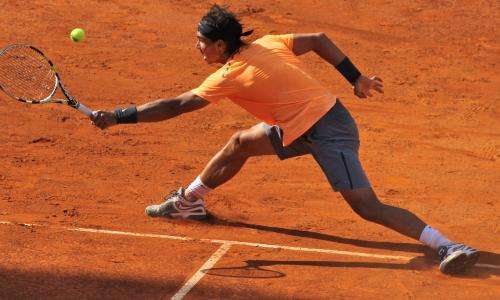Mathematical ranking classifies tennis players by assessing their play

Researchers from the Miguel Hernández University of Elche have used mathematical techniques and the game statistics from the Association of Tennis Professionals (ATP) to rank tennis players based on assessing their play and thus complement the ATP ranking obtained on the basis of matches won during the competition.
The Association of Tennis Professionals (ATP) ranking reflects tennis players' competition performance, and the ranking is based on the total tournaments and tournament rounds won over the year as a whole. Researchers from the Miguel Hernández University of Elche wanted to go further and so prepared a ranking system based on mathematical techniques and the player data provided by the ATP to see which tennis players play best.
"The results have shown, in particular, that Rafa Nadal has the highest score when assessed by the patterns of play of the most efficient tennis players. This has earned him first place in our ranking, followed by Djokovic and Federer," explains to SINC José Luis Ruiz, from the Miguel Hernández University, co-author of the study.
It is worth remembering that in 2009, the year analysed by the study, Federer achieved first place on the ATP ranking; therefore we can draw the conclusion from this study that, although the assessment of Nadal's and Djokovic's play comes out higher than Federer's, Federer competed better.
"The ranking proposed in this study is also obtained from the players' play statistics put together by ATP, such as the percentage of points won on the first serve, break points converted, games won returning a serve, etc. With this information we can find out, in particular, who is the best player in each of these scenarios in the match. However, the ATP does not provide a ranking that reflects player performance in all aspects of play at the same time," Ruiz notes.
To obtain these placings from ATP data, the experts used two mathematical techniques: the Data Envelopment Analysis (DEA) and Cross-efficiency Evaluation. As the researcher explains, when a player is assessed using the DEA technique, a mathematical model on the computer assigns each feature of play the significance most relevant to this player, bearing in mind the particular features of his play.
"Following this procedure we obtain a scoring which we can interpret as that which results from assessing him with the pattern of play that is most in his favour. This 'self-evaluation' is performed for each player, such that those who receive the highest scores are considered the most efficient players, while the remainder are classed as inefficient," he highlights.
Thus, the researchers have identified the weaknesses of the most inefficient players and compared them to the play of some of the efficient players chosen as 'referents'. "In this way we can suggest possible avenues for these players to improve their play compared with that of the other referents," the researcher concludes.
The ranking of the 10 most efficient tennis players by their play are: Nadal, Dojokovic, Federer, Murray, Verdasco, Davydenko, Gonzalez, Soderling, Roddick, del Potro.
More information: Ruiz, J., Pastor, D. and Pastor, J. Assessing Professional Tennis Players Using Data Envelopment Analysis (DEA), Journal of Sports Economics 14(3): 276-302, 2013. DOI: 10.1177/1527002511421952
Provided by Plataforma SINC


















